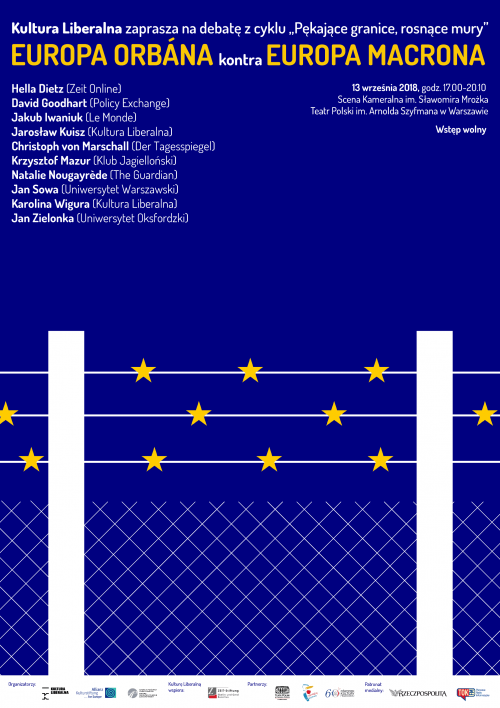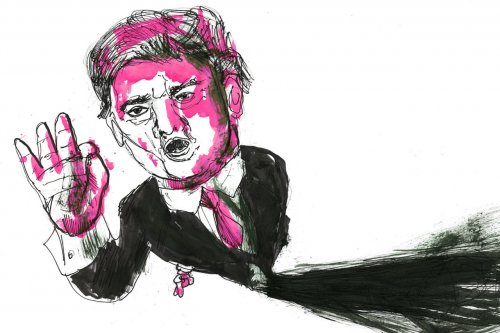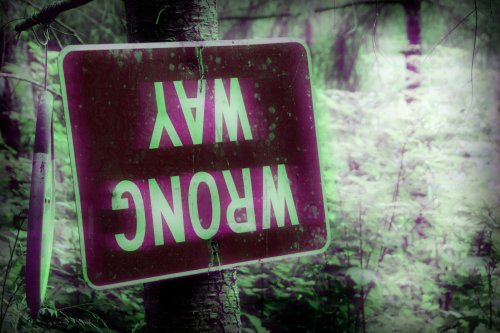Part of the units – once legions – landed on San Domingo in order to suppress the rising of the island’s Black population. Napoleon, who was then committed to reintroducing monarchist customs wanted to bring back slavery on the island – to which its inhabitants of course did not want to agree. The rising, although violently suppressed, led to the creation of independent Haiti. A lot of Polish people – for whom the pacification of the island was against the values and ideas they shared with the rebels – joined the insurgents’ side. To this day, there is a village near Port-au-Prince where the gardens outside the houses look just like the ones we know from the Pan Tadeusz epopee, and its blue-eyed inhabitants are proud of their Polish origins.
For an average Polish person – if they actually do know of Haiti – it is not because of its historical connotations or the goddess Erzulie Dantor who is supposed to be the local reincarnation of the Black Madonna from Częstochowa. They will usually think of voodoo rites, which apparently are an inspiration behind the zombies in Hollywood movies. Meanwhile, the latest documentary of Bartosz Konopka and Piotr Rosołowski, the creators of the Oscar-nominated Rabbit à la Berlin, shows that Haitian culture can be helpful in understanding the events in Poland from two or three decades ago, as well as the “polishness” itself – whatever its definition.
Bokor over the Vistula
The main character, Amon Frémon, was Haitian, but he came from the Haitian-Polish village and was very proud of his ‘legionary’ origins. He was brought up among the rituals mythologized by the anthropologists and ethnologists. He came to Poland (as some storytellers, as well as such prominent experts in theatre as prof. Leszek Kolankiewicz claim) in 1980, thanks to Jerzy Grotowski who was at the time gaining worldwide recognition. With the help of Haitian rites, the explorer of theatrical roots wanted to find the origins of drama and to recreate the voodoo ceremony in Poland. His position at that time was so strong that he could allow himself to bring a Haitian priest to the communist Poland. However, Frémon quickly left his circle and what happened to him next is surrounded with mystery and – as a true historian would say – lacks historical evidence. What is left of him are memories, a few recorded testimonies and the awareness of his Polish links among the inhabitants of his village of origin.
Basing on these relatively few sources, the screenwriters have created a story of Frémon – half fictional, half real, but presented in the same way “the protagonist himself could have told it”. The Haitian voodoo high priest becomes the narrator telling the story of communist Poland under Gierek and Jaruzelski; he is the witness and co-creator of the socio-political changes in our country. Due to the lack of ‘real’ materials, Konopka and Rosołowski had to write a big part of the story from scratch. The creators themselves call Art of Disappearing a fictionalized documentary, but another interpretation is also possible: the film is on the borderline of storytelling, documentary and metaphor, where the protagonist is but a excuse to uncover new layers of our country’s history. Much like in the case of Jerzy Sztwiernia’s Oszołomienie (1988) or Squaring the Cricle of Mike Hodges (1983), no-one in their right mind would claim that this is (respectively) the true story of Kazimierz Junosz-Stępowski or the authentic description of Solidarity’s carnival. Piotr Konopka uses similar tricks to the ones used before in Rabbit à la Berlin which, as such, has no reason to be a documentary. Filling out a whole movie with photos of Berlin rabbits would be impossible and the result – no more interesting than an average nature movie. Thanks to the creators’ efforts, it became an on-screen metaphor for the changes occurring in post-war Berlin. Instead of a trivial documentary on the Polish-Haitian relations, that would be interesting only to few, what we get to watch is a surreal story of the fall of communism in Poland – therefore something much more capturing.
Imported Winkelried
At the beginning, Frémon sees Poland as an odd country that is hard to understand. The communist harvest festivals at the 10th-Anniversary Stadium are for him an irritating ceremony during which young boys and girls make offerings and dance in front of a group of old people (Gierek et consortes). It is a cold, grey place full of rain and strange, tired faces. Slowly, however, the protagonist begins to discover Poland all anew. He starts noticing that Polish people worship a painting similar to the one in Haiti, that Polish villages are as chaotic as the Haitian ones, with their herds of domestic animals and the hopeless awaiting for an improvement to their situation. However, what brings those two nations close the most is death and the attitude towards it. It’s our beautiful arch-Polish death that allows the newcomer from the Caribbean understand our country and eventually, to love it.
It turns out that in both cultures, death is still present and essentially it has been ‘domesticated’. In both, cemeteries are national sanctuaries and independence demanded having shed a lot of blood for. Haitians and Poles have all offered sacrifices to their God – on the Caribbean island it, Haitians offered animals, in Poland – it was the sacrifice of the children who died in the Warsaw Uprising. In this Caribbean-Polish world worlds of the dead and living interpenetrate each other. Mickiewicz’s Forefathers’ Eve is, after all, a Middle European counterpart of conversations with the dead, in which Haitians specialize. Here and there, you also offer the dead a bowl of milk.
The Polish history rediscovered by Frémon is a thousand-year-old ritual of death, religion and suffering. It evolves around the Black Madonna, the corpses of thousands of Varsovians killed in Warsaw Uprising, Mickiewicz (parts of Konwicki’s Lawa combined with the traditional Haitian music make for a stunning effect), Pope John Paul II, Lech Wałęsa or even – juxtaposed with the dictator Duvalier – general Jaruzelski. Frémon uses Haitian terms: John Paul II is someone comparable to Haitian saints, Wałęsa – a hero sent from Heaven, and Jaruzelski – an essence of evil.
Regardless of our personal convictions and of the fact that many Polish people, especially the intellectual elites, for years have been fighting the tendency to define our national identity by decades of mourning, it is the earlier mentioned death and suffering that become for Frémon the indicators of ‘Polishness’. Moreover, he embraces them so much that, much like our heroes of Romanticism age, he decides to sacrifice his soul for the independence of the country. Parts of it reminds of the Messiah of the nations, others – of Braveheart. The great, wonderful country having some mystical connection with the superior powers needs someone who will sacrifice themselves for its sake, like William Wallace or Gustaw-Konrad. That someone is the mystical priest from Haiti, who dearly loves his ‘second fatherland’.
Suffering sells
There is one more storyline that appears in the movie – the idea of a pride of ‘being’ Poland-related that was noticeable among the Haitians from the Polish village, from which Frémon arrived. In Haiti, its inhabitants are actually considered Polish and when pope John Paul II visited the island, it was them who greeted him as the members of the local Polish diaspora. Of course they don’t know the real Poland – information of it sometimes reaches them in the person of Jerzy Grotowski, the pope, soldiers of Grom during a peace operation in 1993 or scientific researchers. Their pride grows out of the myth of a Poland that is full of suffering and dignity.
Drawings such parallels may be deceptive, but the comparison of Poland and Haiti, thanks to the fictitious story of Frémon, shows the exporting potential of our culture. It is not joy, not the great accomplishments of the last two decades, not the pride in regained independence and of newly built roads. It’s the polish romanticism, our eternal closeness to death and sorrow, which has its counterpart in the distant Caribbean. Our sorrow is interesting and poetic – joy is simple and ordinary. The myth of Poland, the martyr among the nations, obviously is not something that is an unambiguously positive thing and it carries a certain risk. But isn’t it a much more sexy way of presenting our country’s history than the dull positivism, which has the potential to excite perhaps only the accountants in the World Bank?
Whether we want it or not – harm and sorrow are more attention-grabbing. What is wrong in basing the national and state myths on what has been both negative and in the past? Does recalling past events not lead to stronger emphasis of current successes? The history of today’s Israel is also based on the memory of Holocaust and its predecessors, not on the story of the calm life of shtetl – and somehow it has not prevented the country from constructing a positive myth over the last sixty years, when the tragic past was juxtaposed with the success of the new society, wealth and the irrigation of the desert. Similarly in the case of Poland – past evil pushes to the fore today’s good. Of course, one needs to remember that the ‘martyr myth’ is just an interlude to the grey everyday life, for which one needs to care; it is a constant pang of conscience and a reminder that good run might come to an end one day. In order to spark an interest in this dull everyday life, one first needs to pass through a stage of fascination with unordinary events. After all, Amon Frémon first discovered Polish tragedies, then sacrificed himself in order to change the course of its history and finally ‘disappeared’ out of sight, when Poland has become a country like any other.
Movie:
Art of Disappearing, dir. Bartosz Konopka and Piotr Rosołowski, Poland 2013.




